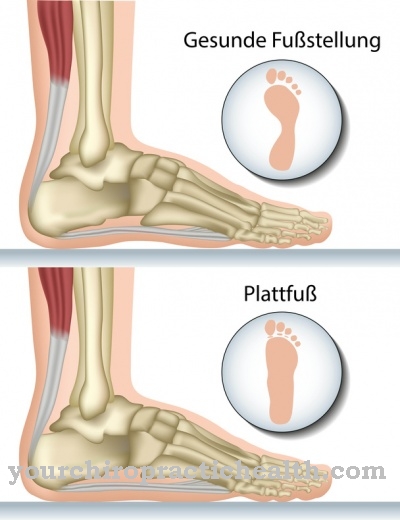The Tracheal stenosis refers to a pathological constriction (medical stenosis) of the windpipe (trachea), which is the connection between the lungs and the outside world. That's why the Narrowing of the trachea sooner or later increasingly to breathing problems and often to pain associated with breathing.
What is tracheal stenosis?

© 7activestudio - stock.adobe.com
In the Tracheal stenosis there is a stenosis (narrowing) of the trachea (windpipe), which makes breathing difficult for the patient. Because the trachea is the only way the lungs can get air.
This is exactly why well-functioning breathing is also extremely important - vital, to be precise. Tracheal stenosis is not only painful, but also often uncomfortable or unreasonable. However, tracheal stenosis only occurs suddenly and drastically in very few cases.
Usually this builds up over a long period of time, so that it can often be recognized and retained in good time. Due to the numerous causes that this disease can show, it can affect people of all ages.
causes
A narrowing of the windpipe or technical language 'Tracheal stenosis on the one hand, can already be innate. Here you should have regular preventive examinations in order to avoid severe symptoms as much as possible.
On the other hand, it can also result from injuries, inflammation and other diseases that affect the airways. In many cases, for example, tracheal stenosis is caused by scarring caused by inflammation and injury. Tracheal stenosis is also frequently triggered by previous long-term ventilation, by benign and malignant growths or by swallowing foreign bodies.
Therefore, children can also be affected by tracheal stenosis, which was either caused entirely by a currently swallowed toy etc., or as an after-effect.
Symptoms, ailments & signs
Most of the time, tracheal stenosis is associated with difficulty breathing and coughing. The urge to cough should stop the narrowing of the windpipe. Quite often, however, this leads to the opposite: The shortage of breath increases. Another characteristic is a whistling sound that occurs every time you inhale. Depending on where the constriction comes from, further complaints arise. They either come on suddenly or they accumulate over a long period of time.
In the first case, a foreign body usually wedges the larynx. Then there is also bleeding. Those affected should not underestimate shortness of breath. It is an immediate danger to life because the lungs are not supplied with air in any other way. In less severe cases, part of a lung is often inflamed.
In addition to coughing, patients then also complain of phlegm formation. There is permanent ejection. In addition to this, febrile conditions occur. In extreme cases, a bronchus or windpipe becomes narrowed. Sick people reflexively feel fear of death. Women and men seem to be suffocating. Sometimes they panic suddenly. A sometimes vigorous choking is characteristic. The apparent foreign body should thereby loosen. The blood pressure often drops sharply. There is a risk of cardiac arrest if no doctor is called in.
Diagnosis & course
Depending on the cause, a Tracheal stenosis run more or less quickly and drastically. If objects are swallowed, tracheal stenosis naturally occurs immediately and is manifested by strong symptoms such as pain and shortness of breath. If the narrowing is not acute, however, the symptoms and complaints appear rather slowly. But how slowly cannot be generalized. That is why you should definitely consult a doctor if you have shortness of breath or breathing difficult.
They usually diagnose tracheal stenosis through detailed examinations of the airways and lungs: for example, through X-ray and ultrasound examinations as well as through mirror images. In the case of more severe complaints and if necessary, extensive CT examinations are often used today.
Complications
Tracheal stenosis results in serious complications for those affected. If an object is swallowed, it leads to acute shortness of breath and after just a few minutes to suffocation. At the same time, severe pain and panic attacks usually occur. Immediate treatment is essential, otherwise the shortness of breath increases and the person affected can no longer breathe.
In addition to the risk of suffocation, there is also the risk that the foreign body could slip into the windpipe or esophagus and cause injuries. The tracheal stenosis itself usually does not result in any acute complications, but can cause long-term effects. A non-acute constriction can lead to chronic oxygen deficiency. The affected person is less productive and often suffers from mental deficits such as concentration disorders and forgetfulness.
In the long term, permanent brain damage can occur. Treatment with a stent can lead to injuries. Sometimes the area of skin around the stent becomes inflamed, which in the worst case scenario can lead to an infection of the windpipe. Surgery carries similar risks and can also be associated with problems with wound healing and the formation of scars.
When should you go to the doctor?
An emergency doctor must be called in the event of acute tracheal stenosis. The affected person may have severe shortness of breath and severe pain. If left untreated, there is a risk of suffocation in acute tracheal stenosis. In addition, the triggering foreign body can slip into the trachea or esophagus and cause internal injuries. Congenital or acquired tracheal stenosis should also be clarified by a doctor. If typical symptoms such as shortness of breath, throat irritation and phlegm formation occur, this is a case for the doctor.
Difficulty concentrating and a generally limited mental performance are typical warning signs that need to be clarified by a doctor. The affected person should consult the ENT doctor or family doctor, who can perform an examination and suggest treatment. Otherwise, serious complications, including asphyxiation, can arise. Depending on the cause, the tracheal stenosis is treated either surgically or with a stent. Widening the windpipe is a complicated procedure, which is why those affected usually have to consult the ENT doctor regularly even after the initial treatment.
Treatment & Therapy
Also treating a Tracheal stenosis primarily depends on the cause. However, purely drug treatments are only feasible and useful in very few cases.
Often you have to resort to surgical procedures for even milder symptoms and types. However, these do not always have to be large, which is why one should not postpone a visit to the doctor out of fear. For example, disturbing foreign tissue such as growths can often be removed relatively gently and easily by means of a small bronchoscopic operation.
In addition, in the case of less drastic constrictions of the trachea, stents are used, which widen the trachea. These interventions are often almost painless and only take a few minutes. Incidentally, depending on the cause, stents can remain in place for a lifetime. In severe cases, however, a more extensive operation may be necessary.
In this case, for example, the affected section of the windpipe is removed and the remaining parts of the windpipe are reconnected by modern means, and often with the support of artificial ventilation methods. In the best case, an almost tension and pain-free original state can be restored.
You can find your medication here
➔ Medication for shortness of breath and lung problemsprevention
One Tracheal stenosis cannot be prevented. Only narrowing caused by swallowing can occasionally be avoided with a certain measure of caution. You should keep a particularly close eye on small children here. However, you can always consult a doctor at the first signs so that action can be taken in good time.
In addition, you should undergo regular preventive examinations for long-lasting, chronic or congenital complaints. In this way, drastic symptoms and thus more drastic treatment methods can often be avoided.
Aftercare
After tracheal stenosis surgery, the patient should be able to breathe freely. During the hospital stay, regular airway checks are carried out daily up to the tenth day after the operation. During the first month after clinical discharge, the airways will continue to be checked on an outpatient basis at least once a week.
If the healing process is positive, six-monthly checks of the airways are sufficient from the second month after clinical discharge. Small scars remain on the patient's lower neck. It makes sense to take an antibiotic immediately after the operation. The natural defenses of the body can be supported in this way.
Further medication is generally not required in order to heal the surgical wound. An inhalation treatment can promote the healing process. Inhalation has a decongestant effect on the lung tissue irritated by the operation. Existing pain can be alleviated in this way. The inhalation treatment should be continued for at least one month.
After the clinical stay, follow-up treatment in a special clinic is recommended. The tracheal stenosis is considered to have completely healed as soon as the airways are fully functional. In individual cases, the trachea may narrow again during the healing process. A permanent tracheotomy may be necessary. The aftercare then focuses on rehabilitation measures with the focus on "Living without outside help".
You can do that yourself
The treatment of tracheal stenosis can be supported by various measures. After intubation, the patient must recover from anesthesia. The doctor regularly checks the heartbeat and breathing rate in order to detect complications early on.
A change in diet is a complementary measure. Only light foods that do not irritate the windpipe may be consumed. Cold, hot or spicy foods should be avoided. Likewise alcohol, coffee or nicotine. If the pain persists, it is best to consult a doctor.
Tracheal stenosis is a serious condition that is usually associated with limitations. No strenuous sports should be performed before the constriction is removed, as there is a risk of shortness of breath. In addition, the windpipe should not be additionally burdened by luxury foods or medication.
After a tracheostomy, attention should be paid to pain, pressure, or heartburn, as these are typical symptoms that indicate a complication. If there are signs of infection or injury, the doctor should be consulted quickly. Bleeding and loss of the airways are the main problems. At best, the patient is also monitored while sleeping for the first few days and weeks.












.jpg)



.jpg)










.jpg)
